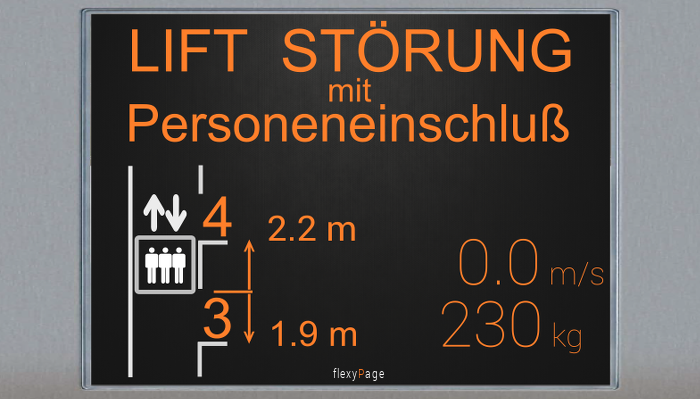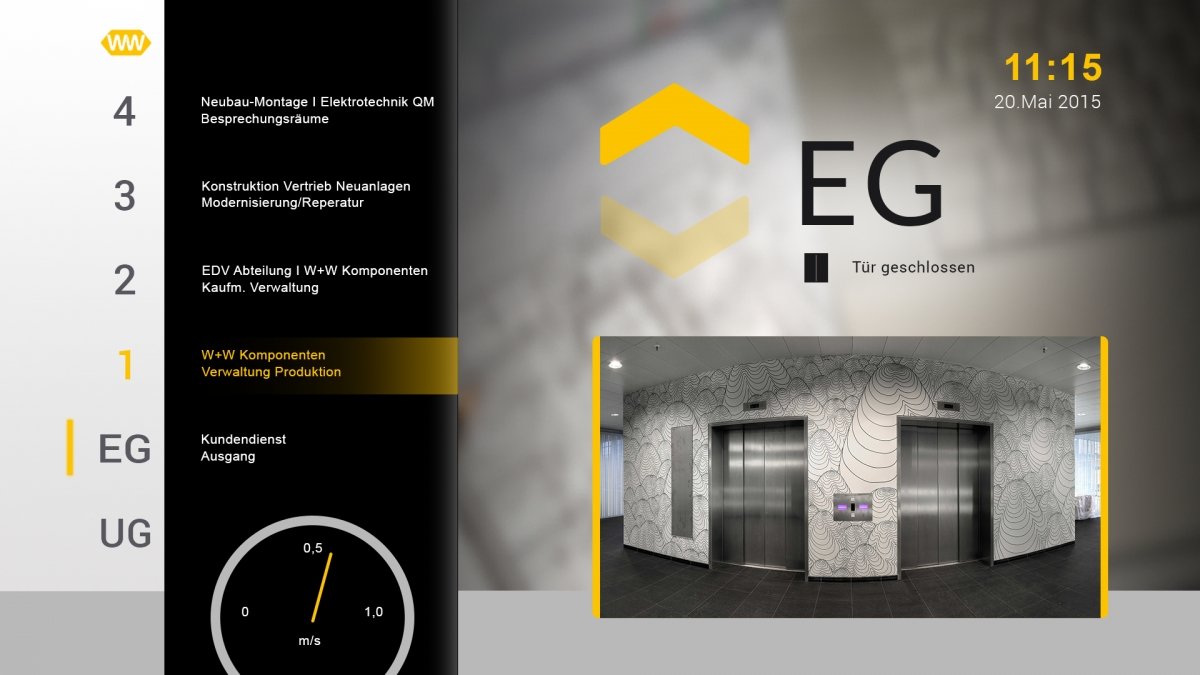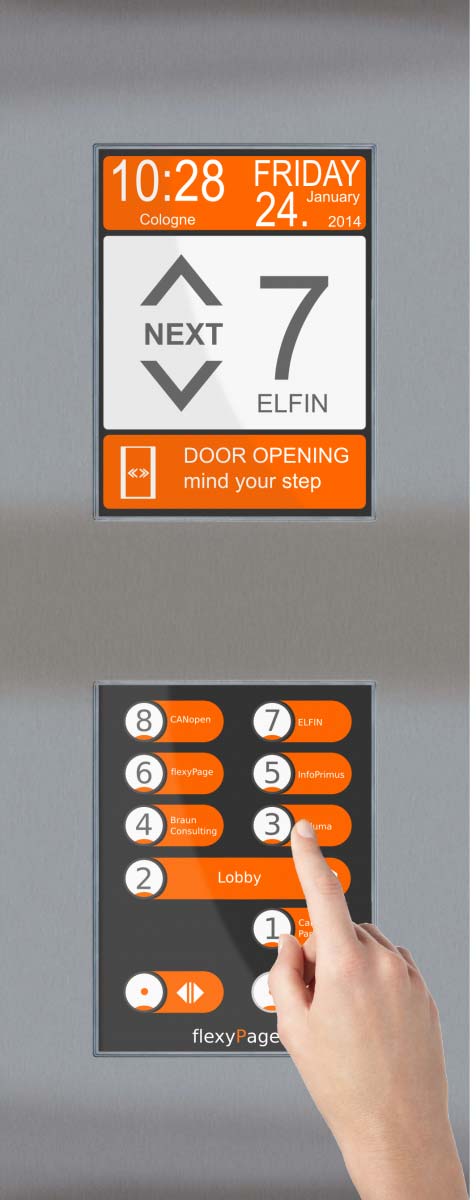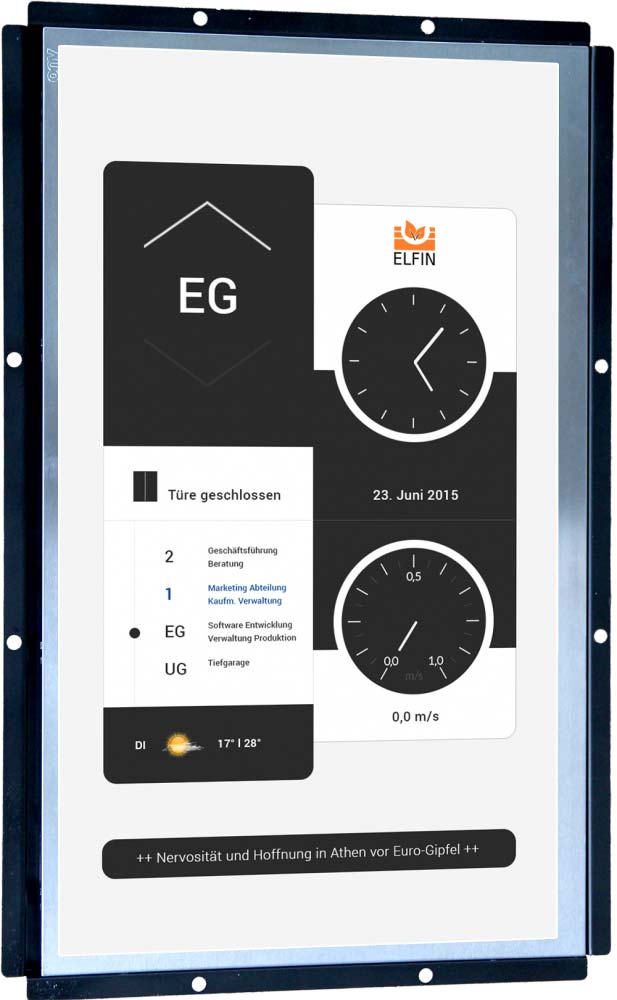
High-definition TFT displays are being used in an increasing number of applications. They allow large amounts of information to be displayed on a relatively small area. The large number of applications is not only owed to the advantageous price of the display panels but also to the expectations of users who use smartphones and tablet PCs everywhere and expect such common user interface also from other appliances and machines.

Fig. 1: Display of location and load in case of a failure on a display iat the elevator's main entrance.
High-end displays at direct eye level in elevators enhance the passenger’s attention and shorten the perception of the time spent waiting for the elevator to arrive as well as the perceived riding time. But there is more to it. Modern TFT displays can be used to transfer to the passengers a lot of useful information on the elevator and building. Apart from familiar status reports (current floor number and riding direction) many other messages can be displayed such as operating modes (‚Use the emergency exit in case of fire!‘, ‚Elevator is being serviced‘), notes on special rides (bed transport in hospitals) and safety instructions (‚Mind your step‘ or ‚Caution – door closes‘).
Apart from the service life and the long-term availability, an industrial use has to cope with a number of major challenges such as the high number of interfaces and protocols that need to be adapted for each application. This requires high-capacity microprocessors with a low energy demand and only producing small amounts of heat.
Another challenge is the configuration of the displays. Equipment offered on the market often has a very restricted scope of functions or extremely complicated configuration tools are needed for the large amount of adjustable functions. This is where flexyPage follows a new approach and for the first time offers a combination of a high-capacity hardware with a very low energy demand. This is possible because mobile processors combined with many standardized interfaces from the industrial environment are used which are freely customizable via an easily operated Web surface.
In this article we would like to explain some of the features of flexyPage displays and show why this makes them predestined for many applications in lifts.

Fig. 2: Networked TFT displays in an elevator allow lift and sensor data to be displayed together with building information and advertisements.
CANopen-Lift as elevator interface

Fig. 3: Calls can be made using the touch sensors.
Apart from an appealing look, a modern hall call or elevator car display must primarily provide the passenger with the required and useful information on how to use the elevator. This requires the signals for the floor number, ride direction, overload or a special ride to be displayed.In the past this was achieved by means of discrete signals which had to be wired from the controller to every single display which requires a lot of work and no longer meets modern requirements. A connection of the displays via the open CANopen-Lift standard offers a solution. By accessing the field bus of the elevator, the entire scope of elevator system information is available to the display and opens up many new possibilities to provide passengers with useful information.
The display for example can directly call upon the information about the current location and speed of the elevator. And this not only fulfils the purpose of entertaining the passengers during a ride in high towers. The display can also analyze the ride movements and for example give passengers a ‚Mind your step‘ warning when the car floor is not level with the landing floor.
The CAN bus also provides information on the current load in kilograms. A display of the load of an elevator is often required for goods lifts and is also useful in case of elevator system failures with trapped passengers. In such cases the hall call display at the main entrance is not just able to show the ‚out of order‘ message but also the current location and load inside the car together with the information that the safety gear has been tripped, i.e. information allowing the engineer to rescue trapped passengers in less time.
When the display is equipped with a touch screen, not only car calls can be made. The standard CANopen-Lift allows priorised calls to be made, loading times to be activated and access control data to be transmitted. So if one wants to restrict the access, this is not only possible with a correct entry of a PIN number which closes a relay contact but also by realising via the network a wide variety of scenarios by assigning calls, priorities and door times at certain times of the day.
flexyPage displays can be used in every elevator system. When the elevator does not yet support Standard CANopen-Lift, signals are made available via external input/output modules. In this case, too, the networking via the CAN bus offers many benefits. So if during a modernisation a TFT display is to be retrofitted in the car, the necessary signals must be made available by the controller. If there are not sufficient free strands in the trailing cable, a new trailing cable must additionally be installed.
flexyPage displays allow the input/output modules to be directly installed where the signals are available, for example in the controller cabinet before being networked to the display via 2 cables.
When a retroffited display is expected also to display the load, location or speed, the appropriate sensors can be directly connected to the bus. In this case the assessment is directly carried out by the display. As such the networking of components via the CAN bus offers many benefits and possibilities when older systems are modernised.
Web-based Configuration
If one wants to display a lot of information on a large car call or hall call TFT display, a configuration meeting the application requirements needs to be made. In the past manufacturers usually made available a suitable configuration program to be installed on a Windows computer. When the configuration is completed, the configuration files must be transferred to the display or be stored on an SD card or USB stick which are then plugged into the display. This procedure contains a number of disadvantages that are ruled out in flexyPage displays.
flexyPage displays are configured on a web basis meaning that every current web browser already installed on every current PC, tablet or smartphone can be used for configuration purposes. This allows every modern unit to be used for the configuration in a crossplatform mode. Since the configuration dialogues are directly made available by the display, they are also always up-to-date and match the firmware of the display.
 Fig. 4: The web-based configuration allwos a configuration via smartphone or tablet.
Fig. 4: The web-based configuration allwos a configuration via smartphone or tablet.
Widget-based applications
All functions in the flexyPage displays are no longer made available by one single application, but by so-called widgets. Widgets are small programs such as Apps on a smartphone which only occupy a part of the screen. These Widgets provide merely a few functions and can be freely located on the screen and be adapted in the layout depending on the application. Owing to the free selection of different widgets and their adaptation, the large number of applications meeting a wide variety of requirements can be easily realised. More than 30 widgets are currently available in the flexyPage displays that not only display the general elevator functions but also allow the output of sensor data such as the load, location or speed and the multimedia data and web services to be displayed. The complete list of widgets and their description can be found on the product homepage at widget descriptions(link is external).
Widgets do not only permit the layout to be freely adapted. They can also be activated and/or deactivated in a time-driven and event-driven mode. Additionally any function on the display can be activated at certain moments in time. The event control allows widgets to be activated and deactivated whenever certain signals occur. This can e.g. be used to deactivate the output of an advertisement in case of fire and instead display instructions for an evacuation.

Fig. 5: Wiidgets can be freely located on the screen and thus allow complex applications to be realised with ease.
Internet link
The development of the flexyPage displays has been focussed on a connection to the internet as a basis for a large number of new functions.
When a display has an internet link, it can be remotely configured via the flexyPage portal. A connection to the display is achieved exclusively via a safe and coded VPN link which does not necessarily have to be installed by the user himself. The configuration surface can be accessed from everywhere using the current web browser via the flexyPage portal. It can for example be used to update the pictures of a slide show, the menu of a restaurant and also the full layout or function of different widgets.
Apart from the remote configuration possibility, the internet link can also be used for a direct display of internet data on the displays. In this way not only weather data but also the latest news from an RSS feed and other websites can be displayed.
Summary
The capacity of current microprocessors combined with the networking of components via standardised field busses and the connection to the internet offer a wide variety of new possibilities. The modern flexyPage displays of ELFIN GmbH are a good example. The internet is not only used to display a website but also makes available different web services and a remote configuration feature. With the provision of functions via widgets and the webbased configuration the user can easily configure complex applications with every current web browser and a smartphone.
The flexyPage displays are available in different shapes and sizes. For a full portfolio please refer to the homepage flexyPage.de.

Fig. 6: flexyPage display with colored glas front in aluminium frame for elevator retrofitting.
lift report year's issue 41 (2015) magazin 5
lift report 41. Jahrg. (2015) Heft 5
